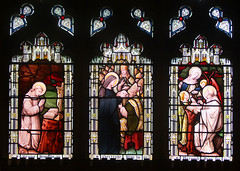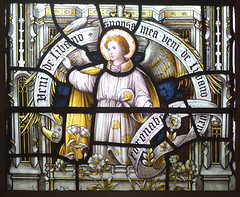| |
|
 |
|
If round-towered Holy
Trinity
around the corner is a glass of chilled
white wine, then this building is an
exotic cocktail of a church. One of those
cocktails with a miniature umbrella, a
couple of sparklers, and chunks of
unfamiliar fruit. The immense tower of St
Mary rears up between the two, the three
churches together forming a kind of
ecclesiologist's theme park.
St Edmund sits on Bungay's busy High
Street in a neat graveyard behind a neat
hedge. It is actually on the site of the
former medieval church of St Thomas of
Canterbury, which once shared a graveyard
with St Mary. It is worth noting in
passing that this church and St Benedict
at nearby Beccles are the only urban
Suffolk Catholic churches with their own
graveyards. By the time Suffolk's
catholic churches were built, the Burial
Acts of the 1860s had been passed,
prohibiting urban churchyard burials. But
Bungay and Beccles were too small for the
Acts to apply to them. |
The church is served by the
Benedictine community, and has a thriving school
immediately next door, giving Bungay a peculiarly
Catholic presence on its High Street. Externally,
it is a remarkable building. Most striking of all
is the massive octagonal structure on the north
side of the front. This is the baptistery, and
what it contains is even more worthy of note. We
will come back to it in an moment. The frieze
above the main entrance shows the martyrdom of St
Edmund, and you step beneath it into a quiet
porch, with no indication of the treasures
beyond.
The contents of Catholic
churches are usually brought together over the
years, as and when their often poor communities
managed to afford them. Not so here. Not only was
St Edmund all built in one go, it was also
completely furnished in the most opulent style at
the same time. You step through into what is
probably the most ornate church in all East
Anglia. The walls are entirely panelled and
carved in wood. Set into them are the Stations of
the Cross. Stone statuary above looks down. The
windows are full of gorgeous coloured glass by
Hardman & Co. The sanctuary glistens with
gilt. It takes your breath away.
The man who made
all this possible is commemorated to the
north of the entrance. His name was
Frederick Smith, and he died in 1903. The
parish is very fortunate to have a church
that, from the start, met its every
liturgical and devotional need. Mind you,
it must leave the Knights of St Columba
twiddling their thumbs a bit.
Around the corner to the baptistery,
then. You pull the curtain aside, and
step into a high, gated room, with the
most stunning font set in the middle of
it. The font is carved in coloured
marble, and the font cover rises above
it. Clearly, Frederick Smith was not
short of a bob or two, and he even
bequeathed a trust to pay for future
repairs. If you come here, you will be
standing in the most significant Art
Nouveau space in Suffolk. |
|
 |
|
|
|

